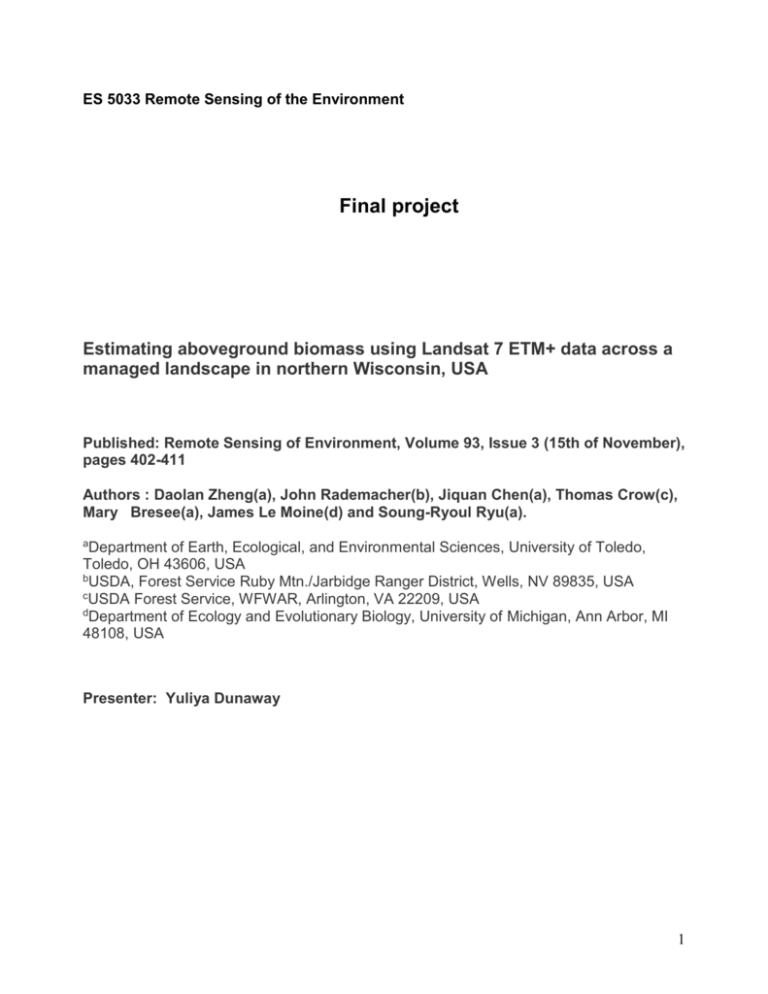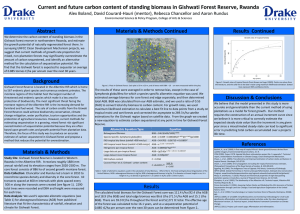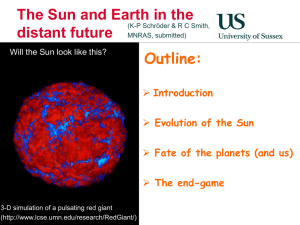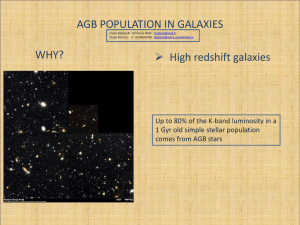doc
advertisement

ES 5033 Remote Sensing of the Environment Final project Estimating aboveground biomass using Landsat 7 ETM+ data across a managed landscape in northern Wisconsin, USA Published: Remote Sensing of Environment, Volume 93, Issue 3 (15th of November), pages 402-411 Authors : Daolan Zheng(a), John Rademacher(b), Jiquan Chen(a), Thomas Crow(c), Mary Bresee(a), James Le Moine(d) and Soung-Ryoul Ryu(a). aDepartment of Earth, Ecological, and Environmental Sciences, University of Toledo, Toledo, OH 43606, USA bUSDA, Forest Service Ruby Mtn./Jarbidge Ranger District, Wells, NV 89835, USA cUSDA Forest Service, WFWAR, Arlington, VA 22209, USA dDepartment of Ecology and Evolutionary Biology, University of Michigan, Ann Arbor, MI 48108, USA Presenter: Yuliya Dunaway 1 Abstract Aboveground biomass (AGB; Mg/ha) is defined in this study as a biomass of growing stock trees greater than 2.5 cm in diameter at breast height (dbh) for stands >5 years and all trees taller than 1.3 m for stands <5 years. Although AGB is an important variable for evaluating ecosystem function and structure across the landscape, such estimates are difficult to generate without high-resolution satellite data. This study bridges the application of remote sensing techniques with various forest management practices in Chequamegon National Forest (CNF), Wisconsin, USA by producing a high-resolution stand age map and a spatially explicit AGB map. Authors coupled AGB values, calculated from field measurements of tree dbh, with various vegetation indices derived from Landsat 7 ETM+ data through multiple regression analyses to produce an initial biomass map. The initial biomass map was overlaid with a land-cover map to generate a stand age map. Biomass threshold values for each age category (e.g., young, intermediate, and mature) were determined through field observations and frequency analysis of initial biomass estimates by major cover types. Authors found that AGB estimates for hardwood forests were strongly related to stand age and near-infrared reflectance (r2=0.95) while the AGB for pine forests was strongly related to the corrected normalized difference vegetation index (NDVIc; r2=0.86). Separating hardwoods from pine forests improved the AGB estimates in the area substantially, compared to overall regression (r2=0.82). The AGB results are comparable to previously reported values in the area. The total amount of AGB in the study area for 2001 was estimated as 3.3 million metric tons (dry weight), 76.5% of which was in hardwood and mixed hardwood/pine forests. AGB ranged from 1 to 358 Mg/ha with an average of 70 and a standard deviation of 54 Mg/ha. The AGB class with the highest percentage (16.1%) was between 81 and 100 Mg/ha. Forests with biomass values >200 Mg/ha accounted for less than 3% of the study area and were usually associated with mature hardwood forests. Estimated AGB was validated using independent field measurements (R2=0.67, p<0.001). The AGB and age maps can be used as baseline information for future landscape level studies such as quantifying the regional carbon budget, accumulating fuel, or monitoring management practices. Article Outline 1. Introduction 2. Materials and methods 2.1. Study area 2.2. Field design and measurements of tree dbh 2.3. Biomass estimation 2.4. Remotely sensed indices 2.5. Relating ground data with the processed remote sensing indices to produce maps of initial AGB, age, and final AGB 2.6. Model applications and validation 3. Results 4. Conclusions 2 1. Introduction Estimation of aboveground biomass (AGB) is necessary for studying productivity, carbon cycles, nutrient allocation, and fuel accumulation in terrestrial ecosystems. Remote sensing techniques allow scientists to examine properties and processes of ecosystems and their interannual variability at multiple scales because satellite observations can be obtained over large areas of interest. Stand level biomass is frequently calculated from linear and nonlinear regression models established by species with field measurements. Although estimates of AGB vary with species composition, tree height, basal area, and stand structure, bole diameter at breast height (dbh) is the most commonly used and widely available variable for calculating AGB. Numerous regression models have been developed to estimate AGB accurate at tree, plot, and stand levels, they are limited when considering spatial pattern analysis of AGB across the landscape. In order to scale AGB estimates to the landscape level, the estimates have to be linked with various vegetation indices derived by remote sensing data. Past studies have shown varying degrees of success in estimating forest biomass and primary production from remote sensing data in temperate and tropical forests worldwide. Recent studies suggest that such relationships vary temporally and spatially; however, biomass estimates at the landscape level are necessary for understanding processes of the target landscapes and provide baseline data for future studies. To bridge the application of remote sensing techniques with various forest management practices in Chequamegon National Forest (CNF), Wisconsin, USA, authors produced age and AGB maps using both remotely sensed and field-measured stand level data. The overall objectives of this study were to combine field observations and remotely sensed data to: (1) produce a high-resolution age map of the landscape; (2) generate a spatially explicit AGB map using our age map and various vegetation indices as driving variables; and (3) examine spatial patterns of AGB in an intensively managed landscape. Authors implemented three specific steps to meet our study objectives: (a) estimating initial AGB by coupling field measurements with solely remotely sensed data through stepwise regressions for hardwood forests, pine forests, and a combination (i.e., hardwood and pine); (b) obtaining a landscape age map by overlaying the initial AGB map with an existing land-cover map using biomass threshold values, determined by frequency analysis and field observations, to separate young, intermediate, and mature hardwood and pine forests; and (c) refining the initial landscape AGB estimates using a combination of newly developed models incorporating age variable from field observations, other satellite-derived information, and our created age map (Fig. 1a). 3 2. Materials and methods 2.1. Study area The study area is located in the Washburn Ranger District of CNF in northern Wisconsin, USA (Fig. 2), which has been extensively researched during the last decade. The area is characterized by Precambrian shield bedrock and a late Wisconsin-age glaciated landscape. The topography is flat to rolling (elevations ranging from 232 to 459 m), with terrace and pitted outwash landforms composed of deep, coarse-textured soils. The climate is marked by a short/hot summer with a growing season of 120–140 days, and cold winters (−10 °C on average from December and February over a 30-year period. Annual precipitation ranges from 660 to 700 mm. Six dominant cover types in the study area, basically following with slight modifications, were: mixed northern hardwood, thereafter referred to hardwood (HW); jack pine (JP), red pine (RP), mixed hardwood/pine (MIX), regenerating forest/shrub (RFS; including pine barrens), and nonforested bare ground [NFBG; including clearcuts (CC)]. Stand level forest management has been the most dominant factor determining landscape structure in CNF. According to the current forest management plan, mature forests (i.e., pine and hardwoods) were harvested at an average age between 65 and 70 years, which resulted in more or less the even age forest structure across the landscape. 4 2.2. Field design and measurements of tree dbh Fifty-five circular plots used in model construction were established and measured in the 2002 growing season. All were continuous even-aged stands: 2.6 km2 for mature and intermediate aged stands and 1.3 km2 for young and clearcut stands across cover types (i.e., RP, JP, and HW) and age groups. In each cover type, four age classes were sampled (i.e., 3–8, 15–20, 32–40, and 65–75 years) for a total of 12 stands. In each stand, four to five plots were set around its center at a distance of 150 m for the 32–40- and 65– 75-year stands, and 60 m for the 3–8- and 15–20-year stands. The plot area for all cover types and age classes (except for young hardwood) was approximately 0.05 ha. Conversely, the young hardwood plots were approximately 0.01 ha due to high stem density. Within each 0.05-ha plot, the dbh of all trees (>2.5 cm dbh) and the average stand age of the plot were determined by tree ring analysis and recorded. In the young hardwood plot, the dbh of all trees with a height of >1.3 m was measured. Both the 0.05and 0.01-ha areas were located in homogeneous cover types (even age management) within a minimum size of 60×60 m. In addition to the initial 55 plots, 40 validation plots were selected randomly and measured in the 2003 growing season for model validation. The plot selection was based on similar criterion as stands used for model construction. Once a suitable stand was found, a random number table was used to determine plot location (i.e., compass bearing and distance) (Fig. 1b) and dbh of the trees in each subarea (i.e., 0.05 or 0.01 ha) was measured. Field biomass calculated from the measured tree dbh in either 0.05- or 0.01-ha area of the 95 plots was adjusted to 1 ha before being used for model construction and validation. 2.3. Biomass estimation AGB (Mg/ha) is defined in this study as biomass of growing stock trees greater than 2.5 cm dbh for stands >5 years and all trees taller than 1.3 m for stands <5 years, including tree foliage and branches. Previous studies have shown that amount of biomass from shrub and sapling is minimal in forested ecosystems of the region and that the AGB accounts for 92–99% of the total AGB depending on forest type and age. For each sampled tree, AGB was calculated as a function of dbh [AGB=a(dbh)b, where AGB is the oven dry weight, and a and b are regression parameters]. The parameter estimates used were from published literature in the closest geographical regions. Once AGB was calculated using the dbh of all trees species in each plot, authors calculated the sum and converted to megagrams per hectare. 2.4. Remotely sensed indices An ETM+ image of 2001 (June 12) in the study area (46°30′–46°45′N, 91°02′– 91°22′W) was acquired to calculate various vegetation indices. The image was georectified to UTM projection and the raw satellite data in each ETM+ band (except thermal and panchromatic) were converted to reflectance using an exoatmospheric model prior to the calculation of vegetation indices. This study incorporated reflectance in six 5 individual bands [blue, green, red, near-infrared (NIR), and two middle-infrared (MIR)] and five vegetation indices calculated from individual bands as independent variables including: (1) ratio of blue/red; (2) NDVI (NIR−red)/(NIR+red); (3) SR (NIR/red); (4) modified soil adjusted vegetation index (MSAVI), calculated as: MSAVI=(ρNIR−ρred)/(ρNIR−ρred+L)*(1+L), where ρ is reflectance in NIR or red band and L is a soil adjustment factor; (5) NDVIc is calculated from NDVI*[1−(mIR−mIRmin)/(mIRmax−mIRmin)]. 2.5. Relating ground data with the processed remote sensing indices to produce maps of initial AGB, age, and final AGB The spatial location of each plot was acquired using a global positioning system (GPS). A conceptual framework was developed to demonstrate the major steps taken to produce the initial AGB map, age map, and final AGB map using field data and satellite-derived information (Fig. 1a). Authors coupled AGB values calculated from field measurements of tree dbh with five vegetation indices derived from Landset 7ETM+data through multiple regression analyses to produce initial biomass map. The initial biomass map was overlaid with a land cover map to produce age map using biomass threshold values, determined by frequency analysis and field observations to separate young, intermediate and mature pine and hardwood forest (Table 1). The age map was needed because the field observations suggested that the biomass accumulation for hardwood forests was linearly related to stand age due to heavy management practices (e.g., even age harvest). Authors then established new empirical models (Table 2) that were applied to create the final AGB map arcoss the entire landscape using our created age map and the satellite derived landcover map ( Fig. 3). Table 1. The threshold values of AGB (Mg/ha) used to differentiate age classes for pine and hardwood forests in the CNF Cover types Young (4–15 years) [Mg/ha] Intermediate (16–35a and 16–45b years) [Mg/ha] Mature (36+a and 46+b years) [ Mg/ha] Pine 4–19 20–80 >80 Hardwood 4–39 40–100 >100 The values were determined from frequency analysis of initial AGB map and field observations. Clearcuts were assigned ages <3 years. Pine barrens were assigned ages of 5–25 years. a For pine forests. b For hardwood forests. 6 Table 2. Statistic models used for calculating AGB (Mg/ha) Models Description n r2 AGB=48.8*(NIR/red)+2.3*Age-454*MASVI-38 Overall 55 0.82 AGB=111*(NDVIc10.3/(NDVIc10.3+0.3510.3)) Pine 35 0.86 AGB=232.5*NIR+2.7*Age-71 Hardwood 20 0.95 The models were established from field measurements, Landsat ETM+ individual bands, and various vegetation indices developed from remote sensing data in CNF, WI, USA. Statistically, the model is generally expressed as Y=β0+β1X1…βiXi+ , where Y=the dependent variable; Xi=the independent variable for the ith observation assumed to be measured without error; β0, β1, βi=constant parameters of the system that need to be determined; and =error term, and is usually simplified as above without the error term for practical application. 2.6. Model applications and validation To improve the AGB estimates across the area, authors modified the existing 2001 landcover map slightly by further dividing RFS class into pine barrens, young pine (YP) forests, and young hardwood (YHW) forests according to the land-cover map in 1992 (or earlier, if necessary). The AGBs for all pine and hardwood forests were estimated using pine and hardwood models, respectively. The AGB values for mixed forests were estimated using both models and weighted by their proportions of hardwood and pine species (estimated that the majority of mixed forests in the area has about 60% hardwood and 40% pine species). Additionally, authors used the overall model for PB because it is a unique cover type characterized by a mixture of shrubs and sparse trees (pine dominated). For validation of the estimated AGB, we used 40 randomly selected independent field plots. 7 3. Results Remote sensing derived variables including MSAVI, bands of red, NIR, and MIR were useful predictors of AGB (Table 2). The overall model explained 82% of variance (a=0.001). However, better models were achieved by separating the plots into hardwood and pine forests. Hardwood AGB was strongly related to stand age and NIR (r2=0.95; Table 2) using a linear model, while AGB for pine forests was strongly related to NDVIc using a sigmoidal model(r2=0.86; Fig. 3). The predicted AGB values of final AGB map across the landscape ranged from 1 to 358 Mg/ha, with a mean value of 70 Mg/ha and standard deviation (S.D.) of 54 Mg/ha; consequently, the total AGB in the study area was estimated at 3.3 million metric tons (dry weight). The biomass class with the highest frequency (16.1%) was 81–100 Mg/ha (Fig. 5). The AGB class distribution was skewed toward lower AGB values. Less than 3% of the landscape had AGB >200 Mg/ha. When separating the landscape by cover type, hardwood and mixed forests contained approximately 77% of the total AGB while PB stored less than 3%. Hardwood forests contained more AGB (47%) than mixed forests did (30%) in the area due to its high percentage of area occupancy (35%), although its mean was about the same as that of MIX forests (93 Mg/ha) because 19% of HW was classified as young forests. Pine forests comprised about 20% of the total AGB across the landscape (Fig. 6). Mean AGB value of red pine (57 Mg/ha) was about 33% higher than that of jack pine (43 Mg/ha). Clearcuts had the lowest values in terms of both mean AGB and proportion of total AGB (0.3%). Among the cover types, the AGB estimates for hardwood had the largest variation (S.D.=60 Mg/ha) while the estimates for jack pine had the smallest variation (S.D.=33 Mg/ha) The final estimated AGB values compared reasonably with the independent field observations in the 40 validation plots (R2=0.67; Fig. 7). Spatially, low AGB occurred in RFS and CC areas, while high AGB occurred in mature hardwood forests (Figs. 4a and b). 8 Fig. 2. The geographical location of the study area located in the Wasnburn Ranger District of CNF in the northern Wisconcin, USA 9 Fig.3. relationship between corrected NDVI (NDVIc) and AGB (Mg/ha) of pine forests in CNF (n = 35, p<0.001). Fig.4. Maps for (a) AGB (Mg/ha), (b) land cover, and (c) age map (recorded as a category map to increase the readability). All were derived from 2001 Landsat 7 ETM+ data for CNF. 10 Fig.5. Frequency distribution of AGB (Mg/ha) classes of forest excluding nonforested bare ground in CNF. Fig. 6. Mean AGB (Mg/ha) plus 1 S.D. (vertical bar) by cover types (PB=pine barrens; HW= hardwood; MIX=mixed hardwood/pine; CC=clearcuts; JP=jack pine; and RP=red pine). The numbers in parentheses inticate proportions of AGB (%) for each cover type in relation to the total AGB across the landscape. 11 Fig. 7. Comparison between predicted AGB (Mg/ha) from the remote sensing-based models and the observed AGB calculated from field tree dbh measurements in CNF (n=40, p=0.001). Each plot represents the AGB for one of the plots and the AGB for the pixel that the plot falls in. Others include clearcuts and mixed forests. 5. Conclusions The AGB map may be used to refine the land-cover classification by differentiating young hardwood forests (with low AGB) from the mature ones. Results from this study may also be used for examining differences in AGB between interior areas and in areas under edge influence, and how those differences may affect landscape level AGB. Our AGB map can be a useful source for estimating aboveground net primary production (ANPP) across the landscape because stand ages in the area are relatively young (only about 3.1% of total CNF land area had forest stands with ages >70 years). A good relationship exists between AGB estimates and ANPP before forest stands reach old stage. The distribution of AGB across the landscape is necessary for quantifying landscape level fuel accumulation and its relationship to fire behavior and intensity. By combining our age map and the AGB map, fuel type and amount may be determined, which can be useful information for studying fire ignition and spread across the landscape. Such information could be helpful for resources managers to conduct fuel reduction plans to prevent 12 catastrophic fire risk. This study provides information for landscape level analyses relating to regional carbon budget (monitoring changes of carbon pool over time). 13







